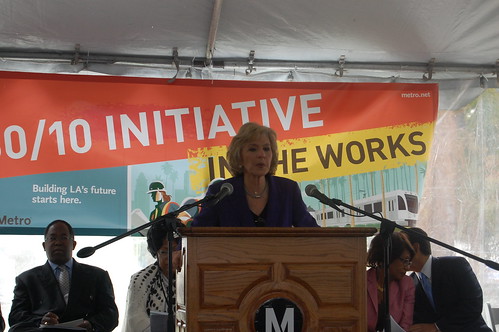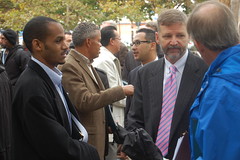
On an atypically dreary day for October, Los Angeles County’s elected representatives from every level of government gathered with community members at Leimert Park to celebrate the receipt of a $546 million loan for the Crenshaw Light Rail project.
The news had already broken on Friday. So above all, this was an opportunity for elected officials to congratulate each other, Metro, and civic leaders for securing the low interest TIFIA loan from the US Department of Transportation.
Several speakers, especially LA County Supervisor Mark Ridley Thomas and Congresswoman Maxine Waters, highlighted the economic and environmental benefits that this project will bring to the South Los Angeles.
But for those following the Mayor’s 30/10 plan closely, the biggest news of the day came embedded amidst the promise of thousands of good paying union jobs and the (somewhat dubious) hope for traffic reduction.
Rather, the key points came from three figures at the federal level, whose work will help determine if the Crenshaw LRT loan is a one-off deal or a veritable down payment on a grander 30/10 scheme.
Firstly, in making a formal declaration of the loan allocation, Under Secretary of Transportation Roy W. Kienitz lauded the spirit of 30/10’s vision, but lamented that “the rules of our funding don’t allow us to do the entire program at once.” How then do you reward one of “the most creative projects,” if the current rules cap the amount of federal loans that can be allocated?

According to Kienitz: support the US DOT and the Los Angeles Congressional Delegation in Washington so that they can “figure out how to rewrite the rules of transportation funding.”
That’s some excitingly bold talk from a senior official in a Transportation Department that has taken a progressive approach to sustainable transportation and its role in livable communities. But ultimately, it will be up to Congress to write the next six-year transportation funding bill and to determine how 30/10 fits into that picture.
Fortunately, Senator Barbara Boxer and Congresswoman Jane Harman embraced the spirit of Kienitz's challenge and ran with it. After lauding 30/10 as a model for communities across California, Sen. Boxer declared that 30/10 “is going to be included in our next transportation bill.”
As if that was not completely clear, Rep. Harman made it utterly unambiguous when she stated that the next transportation bill “will change the formulas for how funding is calculated” for transit projects and that Los Angeles will benefit from these new formulas. Additionally, she got behind President Obama’s proposal for a National Infrastructure Bank and said Congress would be there to fund it.
Given where Mayor Villaraigosa’s 30/10 plan stood in January – a compelling, but rough vision with little official support – it is a little bit amazing to see two powerful members of Congress vowing to rewrite transportation policy on the same day that US DOT hands over a $500 million loan.
While the boost to the Crenshaw project represents something of a milestone for 30/10, some serious heavy lifting remains. Under normal circumstances, there’s enough highway building inertia in transportation funding to kill off good public transit ideas. And on top of that, there’s a monumental mid-term election in two weeks that might result in allies like Rep. Jim Oberstar (D-MN) losing his chairmanship of the House Transportation and Infrastructure committee.
But indeed, there is something compelling about the self-help nature of the Measure R sales tax that transcends ideology and geography. With 30/10, Los Angeles County is doing precisely what any smart small business would do: leveraging its dedicated funding source to guarantee loans that will allow the city to capitalize on labor and materials costs that are the lowest they’ve been in a decade. And in the same motion, 30/10 could put thousands of unemployed construction workers back on the job, not building tract homes on the urban fringe, but building crucial pieces of public transit infrastructure.
In other words, let’s get to work.






